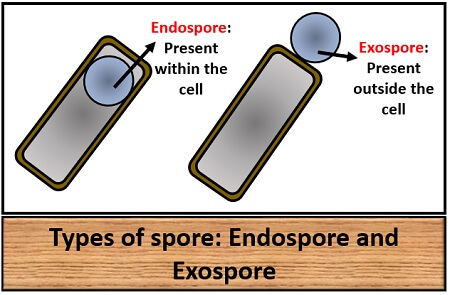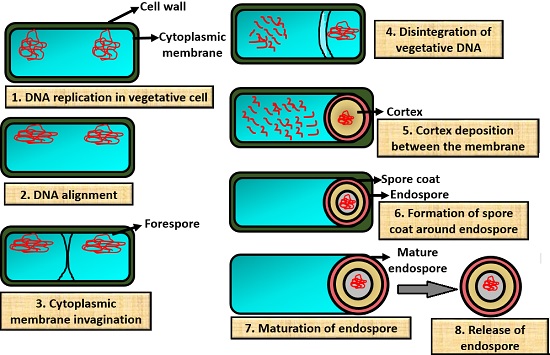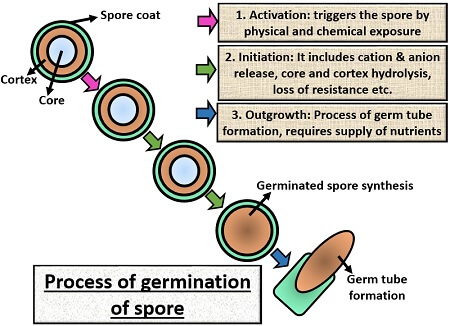Spores are the single-celled structures. These are formed during the unfavourable conditions. They can survive in a harsh environment. Spores are highly resistant structures, which can withstand harsh conditions like high temperature, pH, salt concentration etc. Spores exist in variable shapes, sizes and numbers.
The process of spore formation is called sporulation, and the phenomena where it germinates to form new vegetative bodies is called spore germination. These are unicellular structures and produced by the sporophyte through meiotic cell division.
These are the reproductive structures that form in the life cycle of many plants, fungi, bacteria etc. Spores disperse through the wind or air current. In this context, we will discuss the different cytological events or life cycle of a spore along with its definition, types and structural components.
Content: Spores
Definition of Spore
Spores can be defined as the reproductive structures, which are usually single-celled. It provides the asexual means of reproduction, in which the spores do not need to fuse, unlike gametes. Thus, the spores are generally haploid cells that are produced by meiosis. In its dormant state, the spores are highly resistant to adverse conditions. Spores form new individuals through mitotic cell division once they germinate.
Types of Spores
Spores are broadly classified into two types, namely endospore and exospore based on their position. Endospores are the spores that form within or inside the vegetative cell, while exospores are the spores that form outside the vegetative cell.

Structure of Spore
It consists of the following structural components, which you can see in the diagram that is given below.

- The outer and inner coating is made up of proteins, and its main function is to provide resistance against the chemical and enzymatic actions to the spores.
- Cortex is the region that lies between the inner and outer coat and is made up of peptidoglycan. Its primary function is to protect against dehydration and high temperature.
- Germ wall protects the central core of spores from the potentially damaging chemicals.
- Central core consists of structural components mainly DNA, RNA (small amount), 40% dipiclonic acid (DPA) etc.
Life Cycle of Spores
The life cycle of spores involves the following three events:
- Sporulation
- Dormancy
- Germination

Sporulation of Spores
It is the phenomena of the spore formation by the vegetative cells. Sporulation is also called “Sporogenesis”.
Sporulation of endospore: In this, one vegetative cell forms a single spore, which later germinates into a new vegetative cell. It takes about 8-9 hours, for the sporulation of endospore. Some steps are involved in the sporulation of endospore, which is as follows:

- DNA – Replication in the vegetative cell: First, replication occurs inside the vegetative cell, by which a replica of genetic material (DNA) forms.
- DNA alignment: Then, the alignment of DNA occurs along the cell long axis.
- Cytoplasmic membrane invagination: After that, the cytoplasmic membrane invaginates to form a forespore.
- Vegetative DNA disintegration: Cytoplasmic membrane first grows and then engulfs forespore within the second membrane. Then, the vegetative cell’s DNA disintegrates.
- Cortex deposition: Then, a cortex of calcium and dipiclonic acid deposits between the membrane.
- Spore coat formation: After that, spore coat forms around the endospore
- Maturation of endospore: Then, the maturation of endospore occurs.
- A release of endospore: After the maturation, the fully developed endospore releases out of the vegetative cell, and later germinates into a new individual.
Sporulation of exospore: Exospore forms outside or on the vegetative cell surface. Exospores sporulates through the following steps, which are given below:
- First, the cytoplasmic division occurs in the vegetative cell.
- Then, a small protuberance develops outwards called “Bud”.
- This bud then grows and forms a double-layered membrane outside itself.
- The outer and inner coat develops, resulting in the exospores.
- These exospores then go through the maturation phase and detach after its development.
Dormancy of Spores
It is the mechanism that prevents the germination of the spore into a new vegetative cell, during the unfavourable conditions. Dormancy is subdivided into the following two types:
- Exogenous dormancy
- Endogenous dormancy
Dormancy of spores is generally a stage, in which a spore remains in a resting or dormant state, where it is metabolically inactive. The dormancy is characterized by no cytoplasmic movement and decrease or no metabolic activity. Some internal and external factors can affect dormancy.
Endogenous dormancy: This kind of dormancy is due to internal factors like:
- Internal metabolic block
- Loss of germination promoter
- Production of a certain germination inhibitor
- No nutrient and water penetration into the spore
Exogenous dormancy: This kind of dormancy is due to external factors like temperature and pH variation, desiccation, the absence of light etc.
Germination of Spores
On the return of favourable conditions, the spore germinates or revert to the vegetative state, and the phenomena called germination. It involves the following three steps:
- Activation
- Initiation
- Outgrowth

Activation: In this, the spores are activated or triggered by certain physical or chemical exposure to the spore coat. The agents that trigger the spore involve heat, abrasion, low pH and chemical compounds that contain free sulfhydryl radicals or groups.
Initiation: It is characterized by:
- Swelling of spore
- Rupture of the spore coat
- Loss of resistance to environmental stresses like temperature, pH, oxygen availability etc.
- A release of spore components
- Increase in metabolic activity
Outgrowth: It is the final stage of the spore germination, where a cell prepares itself for a division. This stage requires an adequate supply of essential nutrients for cell growth.
Therefore, all these events like sporulation, dormancy and germination take place in the spore cycle, in which a spore first sporulates, then remains dormant for some time and then germinates into a new vegetative cell through the germ tube.
